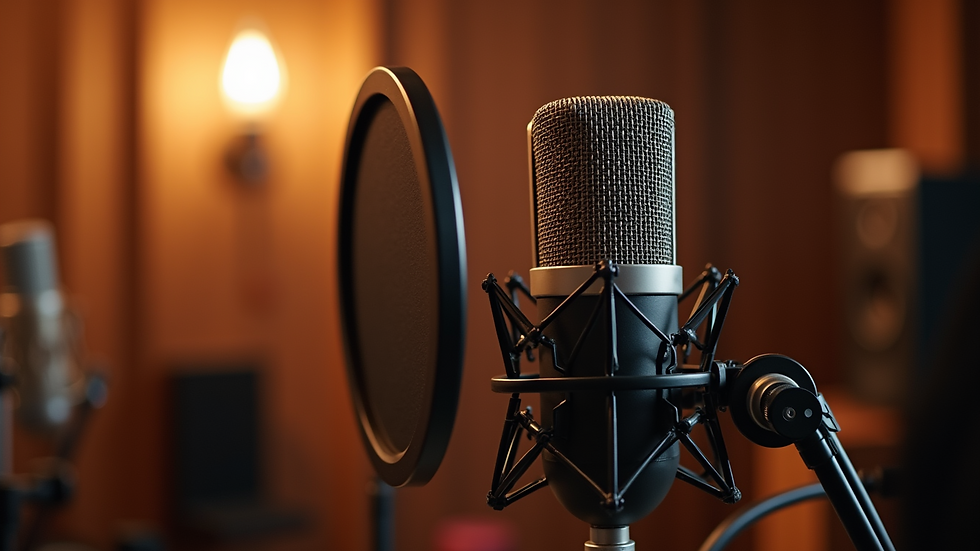Audio Editing for Film and Television
- PsychicUnderLord (Psychic)

- Aug 14
- 4 min read
In the world of film and television, audio editing is often an unsung hero. While engaging visuals draw viewers in, it is the sound design that truly brings stories to life. From the clarity of dialogue to the richness of atmospheric sounds, audio editing plays a crucial role in shaping the viewer's journey. In this blog post, we will explore the core aspects of audio editing, share helpful tips, and provide clear examples to help you master this often-overlooked craft.
The Importance of Audio in Film and Television
When we think about film and television, stunning visuals often take center stage. However, without effective audio, the impact of those visuals diminishes significantly.
Research shows that 70% of viewers consider sound quality critical to their viewing experience. High-quality audio can transform an average film into a compelling narrative. Recall scenes from iconic films like "Inception" or "A Quiet Place," where sound plays a key role in building suspense and emotion. The right mix of sound effects, music, and clear dialogue can evoke deep feelings, enhance tension, and engage the audience fully.
Understanding the Basics of Audio Editing
Before stepping into advanced techniques, it's important to grasp the fundamental elements of audio editing. Here are the key components:
Dialogue: This includes characters' spoken words. For instance, in a dramatic scene, clear and well-mixed dialogue allows the audience to connect with the emotions being portrayed.
Sound Effects: Sounds that enhance realism—think of the loud crack of thunder in a storm scene or the soft rustle of leaves in a peaceful park.
Music: The soundtrack that sets the mood, like a tense score during a chase scene or a soothing melody for a romantic moment.
Foley: Everyday sounds added in post-production, such as footsteps or the clinking of glass, creating an immersive experience.
Ambience: Background sounds that help establish the scene’s environment. For example, the sound of city traffic in an urban setting enhances realism and context.
The Audio Editing Process
The process of audio editing involves several key stages:
1. Pre-Production Planning
Planning the audio elements before filming is crucial. Decide the types of music, sound effects, and dialogue needed. Create a sound design document to outline these elements, ensuring everyone is aligned on the audio vision.
2. Recording
Capturing high-quality audio during filming is essential. Utilizing professional microphones, sound mixers, and proper recording techniques can dramatically improve clarity. For example, using a shotgun microphone can significantly reduce background noise, capturing dialogue clearly even in busy environments.
3. Editing
After filming, audio editors import the recorded audio into software and begin cutting and arranging the tracks. This involves syncing the dialogue with visuals, adding sound effects, and laying down music. Precision is key—one millisecond off can disrupt the viewer’s experience.
4. Mixing
Mixing balances all audio components. Editors use tools like equalization to enhance specific frequencies. For instance, boosting frequencies between 3 kHz and 6 kHz can enhance voice clarity. Techniques such as compression help control audio dynamics, ensuring dialogue remains audible even amidst loud sound effects.
5. Final Review and Mastering
In the final review, all elements are checked for consistency and quality. Adjust levels and finalize the audio to ensure it translates well on various platforms, from theaters to home TVs. Mastering ensures that a film's audio provides an optimal listening experience.
Essential Tools for Audio Editing
Achieving professional audio quality requires the right tools. Here are crucial options:
Digital Audio Workstations (DAWs)
DAWs are software used for recording and editing audio. Some popular options include:
Pro Tools: Renowned for its advanced features, Pro Tools is favored by industry professionals for both music and film audio.
Adobe Audition: This software integrates well with Adobe products, making it ideal for video editors.
Audio Plugins
Plugins enhance audio quality with effects. Key types include:
Equalizers: Adjust frequency balance for clear dialogues and rich music.
Compressors: Control the dynamic range, ensuring all audio elements maintain their presence.
Tips for Effective Audio Editing
Here are some actionable tips to improve your audio editing:
Prioritize Dialogue Clarity
Make dialogue clear and easy to understand. Use equalization to boost vocal tones and eliminate distracting background noise.
Use Sound Effects Wisely
Incorporate sound effects to enhance scenes without overshadowing dialogue. A well-placed sound effect can make a scene memorable, like the creaking of a door before a surprise reveal.
The Future of Audio Editing
As technology evolves, so does audio editing.
Artificial Intelligence
AI tools are emerging that can automatically clean up audio and suggest sound effects, simplifying many editing tasks.
Immersive Audio
With advances in virtual reality, immersive audio is becoming crucial. This creates a sound environment that moves with the viewer, enhancing overall engagement.
Embrace the Art of Sound
Audio editing is a vital yet often undervalued aspect of film and television production. By mastering the basics, using the right tools, and embracing best practices, you can elevate your audio storytelling skillset.
Whether you are a seasoned editor or just starting out, exploring audio editing offers endless opportunities for creativity and innovation. Engage with the power of sound, and watch as your audio transforms your visual narratives into unforgettable experiences.






Comments